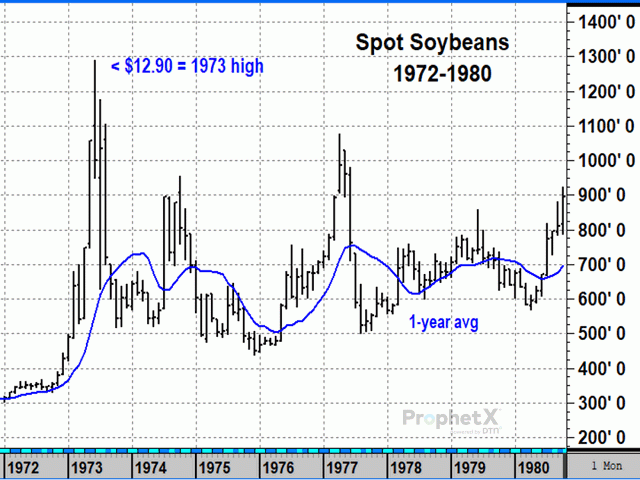Todd's Take
Corn, Soybean Prices Headed Higher. Do I Hear $30?
I had a good time speaking to audiences at the National Farm Machinery Show in Louisville, Kentucky, last week along with DTN Meteorologist John Baranick. Baranick gave his best forecasts for the spring and summer seasons in 2022, and also helped us understand the pros and cons of the forecasts. I appreciated how he explained the fall forecast was based on analog years, but was still too far out to have much confidence in.
As you may know by now, I also have a similar approach that tries to be transparent when explaining markets and giving guidance on what prices to expect in 2022. The way I look at the world, understanding the context of basic fundamental information is a good starting point, but by no means is the end of the story.
As explained in last week's Todd's Take (https://www.dtnpf.com/…), fundamental market information can have its own flaws and tends to look backward. There is no good mathematical formula for taking past data and spitting out future prices. As I often say, markets are people and people are emotional, especially as we navigate new uncertain challenges. One of the things the meteorologist and the market analyst have in common is that neither of us has the luxury of 100% certainty.
For those trying to market their grain, the lack of certainty can be unsettling, especially when the family's finances are riding on the outcome. Deciding when to sell can make a big difference to the bottom line.
The approach of DTN's Six Factors Market Strategies and my own personal approach when explaining markets has been to focus on the most important things that we reasonably know about that are driving the market, identify the things we don't know and then assess the entire landscape the best we can, while also acknowledging the risk in front of us. I commonly describe the process as a poker game: Do we have the confidence to bet all our chips on prices going higher, or are prices high enough to take some risk off the table?
P[L1] D[0x0] M[300x250] OOP[F] ADUNIT[] T[]
I also understand that, for many, the process of struggling with uncertainty is not pleasant, and it's normal to want someone to just give us the answer. Tell me soybeans are going to $20 and be done with it. I could live in that world, but the problem is, I don't know where it exists.
I bring that up because, along with the excitement of this year's higher prices at the farm show, much of the talk was abuzz over the latest predictions being tossed around, and there was mention of the possibility of $30 soybeans. I admit, making predictions can be fun, and it sure gets the imagination going, but I have to ask, is that the kind of thing I would want to bet my family's finances on?
From talking to others at the show, some were referencing high prices related to past price peaks, indexed for inflation. For example, the 1974 spot high in corn of $4 translates to a current price of $22 today. The 1973 high of $12.90 in soybeans is equivalent to $78.86. Does that somehow mean corn is headed to $22, and beans are going to $78? Sorry, but I just don't see the logic.
I remember my grandfather yearning for parity in older days, but the relationship between the consumer price index and grain prices tends to go their separate ways over time, largely due to specific changes in productivity. Today's corn and soybean markets are bullish, but the world is far different than the one we experienced in 1974.
Early in the summer of 1918, corn prices in Chicago traded at the then-exorbitant price of $2.20 per bushel, and soybeans reached $4. Factored for inflation, today's equivalent price for corn is $39.80 per bushel and for soybeans is $72.38 (thanks to the Minneapolis Federal Reserve for the inflation table at https://www.minneapolisfed.org/…).
Now, 104 years later, we are still waiting for those peaks to be matched. By the way, there's probably an inflation-indexed gap that is still not filled yet either.
As I explained in Louisville, there are plenty of bullish forces driving corn and soybean prices higher today. Also, Baranick's early forecast for the U.S. included above-normal temperatures and below-normal precipitation for much of the summer months. At this point, we can't rule out the possibility of extremely high corn and soybean prices in 2022, especially with the threat of drought looming over much of the Midwest.
I'm in no hurry to recommend pricing new-crop corn or soybeans in 2022, but not because I'm blindly betting the farm on any prediction. This is a time to keep our eyes open and look forward, not back at the past.
**
Comments above are for educational purposes only and are not meant as specific trade recommendations. The buying and selling of grain or grain futures or options involve substantial risk and are not suitable for everyone.
Todd Hultman can be reached at Todd.Hultman@dtn.com
Follow him on Twitter @ToddHultman1
(c) Copyright 2022 DTN, LLC. All rights reserved.




